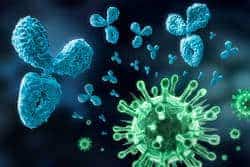Results from neutron spin-echo analysis at the Institut Laue-Langevin (ILL) and the National Center of Neutron Research (NCNR) in the United States are an important advance towards enabling subcutaneous injections of concentrated biopharmaceuticals used to treat cancer and autoimmune disorders (e.g. arthritis, multiple sclerosis). The insights obtained could help drug companies reduce the viscosity and mitigate phase separation in injectable biopharmaceuticals, making them easier to manufacture and fluid enough to be self-administered in the home.
Scientists have used small-angle neutron scattering (SANS) and neutron spin-echo (NSE) techniques for the first time to understand how monoclonal antibodies (mAbs), a class of targeted biopharmaceuticals used to treat autoimmune disorders and cancer, dynamically cluster and move in high concentration solutions. Certain mAb cluster arrangements can thicken pharmaceutical solutions; they could thus limit the feasible concentration of injectables administered to patients around the world. The insights provided by a team of neutron scientists from the National Center of Neutron Research (NCNR) and the Institut Laue-Langevin (ILL), in collaboration with colloid and proteins scientists at the University of Delaware and biopharmaceutical company Genentech (a member of the Roche group), are an important step towards the development and manufacture of high-concentration biopharmaceuticals needed for high-dose indications and potential self-administration at home.
Monoclonal antibodies (mAbs) are proving to be a vital tool in modern pharmacology, providing the basis for a growing number of successful drugs for cancer and autoimmune disorders such as arthritis and multiple sclerosis. As agents for targeted therapy with a good safety profile, they are an alternative to harsher chemotherapy treatment.
The mAbs work by attaching themselves to specific protein targets on cancerous cells, or blocking target proteins in a known biochemical pathway responsible for a disease. These treatments usually require high doses, and lately in some indications there has been considerable interest in moving from intravenous (IV) delivery to a more convenient subcutaneous (SC) delivery – a shallow injection into the cutis just below the skin (such as the home treatments offered to sufferers of type 1 diabetes). However, progress has been hampered by the high viscosity of solutions containing high amounts of mAbs, and this provides challenges to efficient and economical large-scale production, purification, and delivery of these drugs.
“For some proteins at concentrations higher than 100 mg/ml, you can’t deliver them fast enough through thin, SC injection needles, so repeat visits to the hospital with intravenous drips are needed,” explains Prof. Yun Liu from the National Center of Neutron Research (NCNR) in the US, who is also affiliated with the University of Delaware. “The thickening may also cause problems in processing, when filtration pressures are too high, for example, or during freeze and thaw in large tanks where potential gelation or phase separation of the freeze concentrate can occur.”
As a result, efforts to find ways to raise the concentration of monoclonal antibody pharmaceuticals are focused on understanding the root cause of this thickening. Previous studies using static light scattering (Lilyestrom et al, 2013) on concentrated mAb solutions had suggested a strong link between the development of protein clustering formations and increases in viscosity.
In this latest study (Yearley et al. 2014) led by Prof. Yun Liu (NCNR) and Dr. Dan Zarraga from Genentech, in collaboration with the Institut Laue-Langevin (ILL) in Grenoble, small-angle neutron scattering (SANS) and neutron spin-echo (NSE) techniques were used to study the structure and dynamics of mAb clustering responsible for the bulk solution properties. Two types of antibody were placed in solution – one known to increase solution viscosity and one which did not – so any differences in behaviour could be observed. Neutron spin-echo (NSE) measures cluster dynamics by determining their self diffusivity (as opposed to collective diffusivity measured in dynamic light scattering). Neutrons are able to probe very high concentrations since they are scattered only by nuclei (these occupy very little space and thus appear dilute in the neutron beam’s perspective). Also the unrivalled high resolution and very high neutron intensity provided by the ILL neutron spin-echo instrument IN15 allowed a systematic exploration of many different mAb samples.
Using this technique for the high viscosity mAb solution the team confirmed the presence of small extended clusters of mAbs with lifetimes sufficiently long to have an impact on bulk solution properties. On the other hand, the diffusivity measured for the low viscosity mAb solution indicated no such clustering at timescales greater than 50 nanoseconds. The two mAbs only differed in the sequence of their complementarity determining region (CDR); this shows that seemingly small changes in the sequence can have profound consequences on mAb solution behaviour.
Taking into account these insights on mAb clustering, recent studies (Zarraga et al 2013; Allmendinger et al 2014) have shown that there is a window of expulsion rates through a thin needle that reversibly disrupts these mAb clusters, helping mitigate the viscosity issue without irreversibly damaging the individual mAbs. This provides a basis for designing an optimal device system for delivering biopharmaceutical injectable solutions at very high concentrations.
The progress made in these studies is due in part to bringing research institutions and industry together to address practical problems. Research institutions in academe and national labs are often in search of applications for their technological solutions, whilst industry encounters practical problems when looking for solutions. In addition, such collaboration can spur research in adjacent, often very important, fields.
Dr Peter Falus, instrument scientist at ILL said: “Whilst the potential impact of these studies on drug design is very exciting, the subject of protein clustering is an extremely interesting area in its own right. A lot of well-known phenomena, such as the cataracts in our eyes, or Alzheimer’s disease, are the results of proteins clustering in our bodies. As a physicist, I am interested in clustering in general, and neutron techniques here at the ILL provide a unique, high-resolution tool to investigate these complex interactions in natural organic systems.”


